The Ultimate Guide to Advancement Systems Implementations
A series of articles with tips, tricks, and specific tools for ensuring you have a successful implementation within your budget and timeline
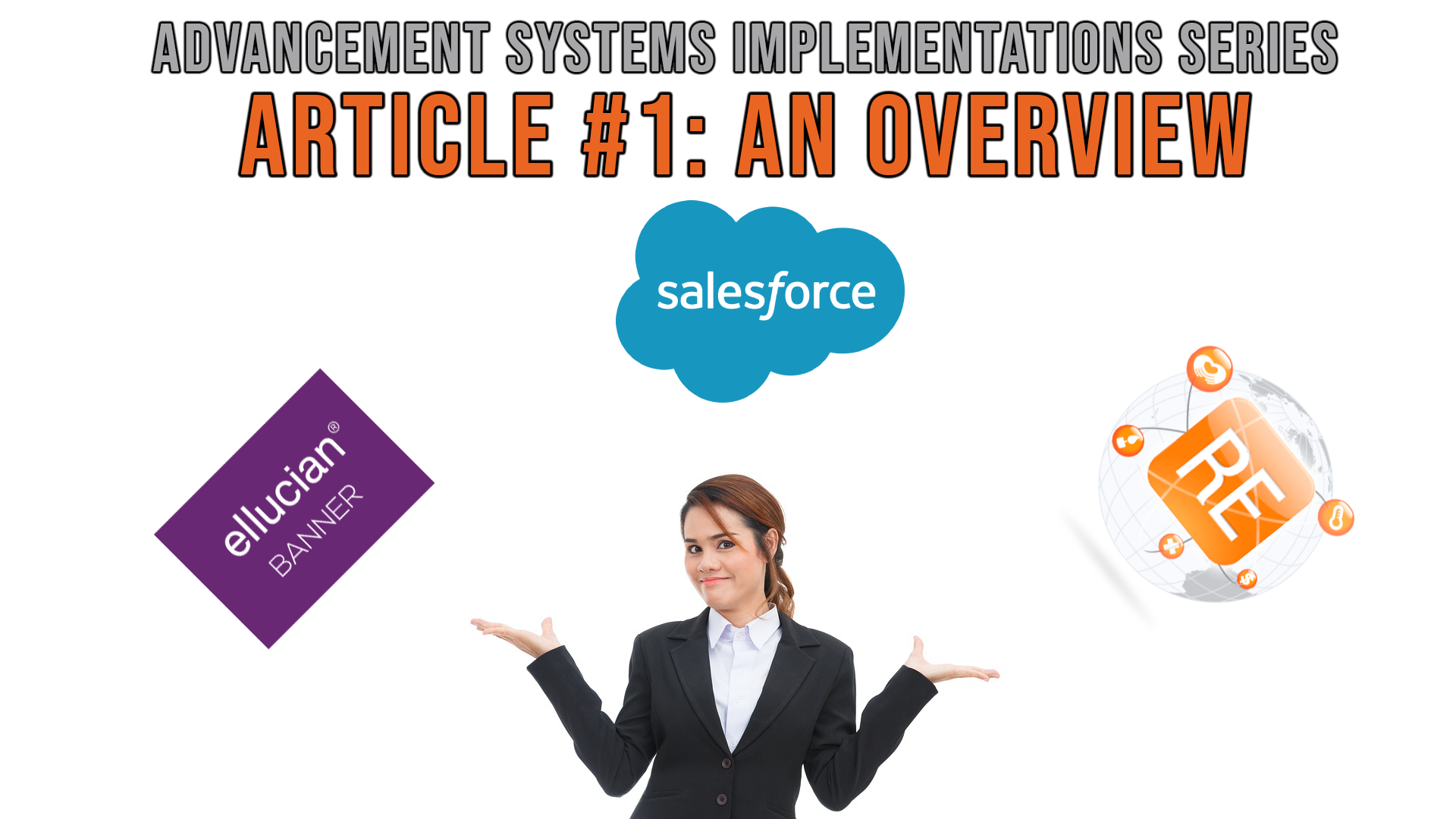
Other Articles In this Series:
An Overview
What Do Your Implementation Teams Look Like?
Implementation Roles
Backfill Support
An Overview
System implementations are complex, challenging and resource taxing. Taking on an implementation should be thoughtful and planned, considering the potential pitfalls, risks and implications.

Terminology
Before we get started it is important to have a clear understanding of the terminology surrounding system implementations. In this overview we will outline some important terms and terminology so you can be informed and have a general understanding of this landscape as you move forward. Each definition will be short and concise as these topics are discussed in detail in future articles, and additional information will be provided including templates, checklists, tips and tricks, as well as the potential risks and pitfalls. A system implementation is the process of adding a new system into your current environment. The implementation can be upgrading or replacing an existing database or application, or it can be adding a new functional system that will fulfill a specific business requirement and integrate with existing systems. A software vendor is a technology company that develops and delivers software to meet a specific business function. This vendor may or may not have a team that has worked in this business function within the industry. The vendor focuses on technical personnel that can be trained to deliver training, data mapping, and data conversion. An implementation partner is an independent company that specializes in implementation system solutions. A good implementation partner understands your unique business processes and has a consulting team that has extensive background serving in your industry. Understanding your industry’s best practices will ensure that delivering your software solution is efficient and you don’t spend your valuable budget explaining the difference between a LYBUNT and a SYBUNT.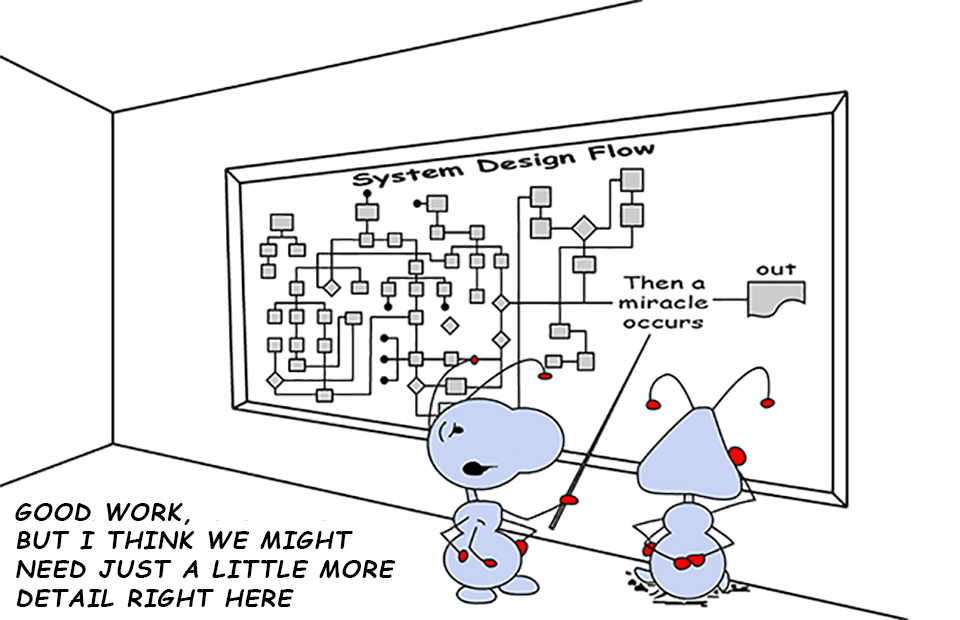
Getting Into the Details: Budgeting and a Timeline
Before you can begin to consider a system implementation, you need to understand your budget.
Approximately how much do you have available and when? Are you looking to implement a large system or a smaller engagement system? Can you work with your senior leadership to identify available one-time capital resources to fund your project?
The numbers don’t need to be exact, but you need to have a ballpark. If you are completely unsure what budget requirements are needed for the system you are considering, it is best to reach out to an implementation partner or a prospective vendor to get some rough data for creating your initial budget.
After you have your budget information, it is important to understand your ideal timeline. When is the best time to move into your new system based upon the business functions that the system will provide? When will your budget be available? Are there current major objectives that are happening within your department or division or organization as a whole that will impact your implementation plans? Do you need your Information Technology department’s support for this project?

It is important to also consider the staff that will be managing the new system and their priorities, vacations, and standard busy times of the year. Make sure you have a clear understanding of when you can move to the new system, and when you cannot move to the new system.
As you work with your selected system vendor and implementation partner, your ideal timeline may be not be possible because of personnel, resources or budget. Utilize a calendar ranking system to understand what is possible and where you need to clearly steer the negotiations.
Who’s Going To Do All of This? Your Core Implementation Team
When you consider your implementation schedule and timeline, it will be important to understand your core implementation team.
This will be the team that is involved with every aspect of the project and will be responsible to ensure the project’s success.
Determining who will internally and externally serve on this team is a critical aspect to any successful implementation project. The makeup of this team should be considered while you are determining your budget and timeline.
Bang For Your Buck: Consider the ROI

After you understand your timeline for the potential system implementation, and your core team has been identified, consider whether any products that you currently own could be maximized to provide the new functionality that you are looking for.
Replacing a system because of new technology and shiny bells and whistles is not a good strategy. It can be expensive and risky.
As a non-profit, the ROI (Return on Investment) for any new system implementation should also be considered. Sometimes the costs of adding a system that ‘will help’ with a business process far exceed any clear benefits.
The ROI should not only consider additional fundraising revenue but the impact on the staff and their day-to-day processes, the donor or constituent facing deliverables, and anything that is new whether it is positive or negative.
ROI Continued: Systems Assessments
At this point, consider whether a system assessment would be helpful. This is a report outlining all of the desired business functions compared to the current system’s capabilities.
Note: Make sure whomever is performing your system assessment is aware that you may be going into the RFP process and want to utilize the list of needs identified.

This assessment combined with your office’s ideal timeline and ROI requirements may identify an opportunity to wait. This waiting period can allow your organization to finish a campaign, essential personnel to be hired, data cleanup to be completed, clunky business processes to be revitalized and reworked, and other internal processes to be finished before the implementation begins.
This extra time may help to ensure the success of your project and mitigate some of the risks. The waiting period could be a couple of months, a couple of years or a decade, depending upon your specific circumstances.
If You Need To Wait, Consider a System Rejuvenation
If a significant waiting period is essential, then a system rejuvenation should be considered. Rejuvenation is a process that identifies the gaps between what functions your team is currently utilizing on the database and what functions are available and needed.
Training, data cleanup and/or standardization, change management, integrations, report development, and many other facets are considered with a rejuvenation effort. If your system is not already maximized, adding the functionality from this rejuvenation will help to improve your processes and deliverables as well as bring your team together to make critical workflow and business process decisions.
This team building activity will improve the overall understanding of your current system, data, and business processes, thus preparing the environment for the eventual replacement.
Don’t Get Caught Dead In a Go Live Situation
When your evaluation efforts identify that a new system is essential, it is time to start considering what Go Live really means. This term is not always consistently used across vendors, but here is a guide for understanding the term.
Go Live means that your new system is up and ready to have data entered. Your final data has been converted and validated, and, your operations team is ready to ‘catch up’ from the down time needed for running your conversion.
Work closely with your implementation partner or software vendor to determine the specific cut over plan.
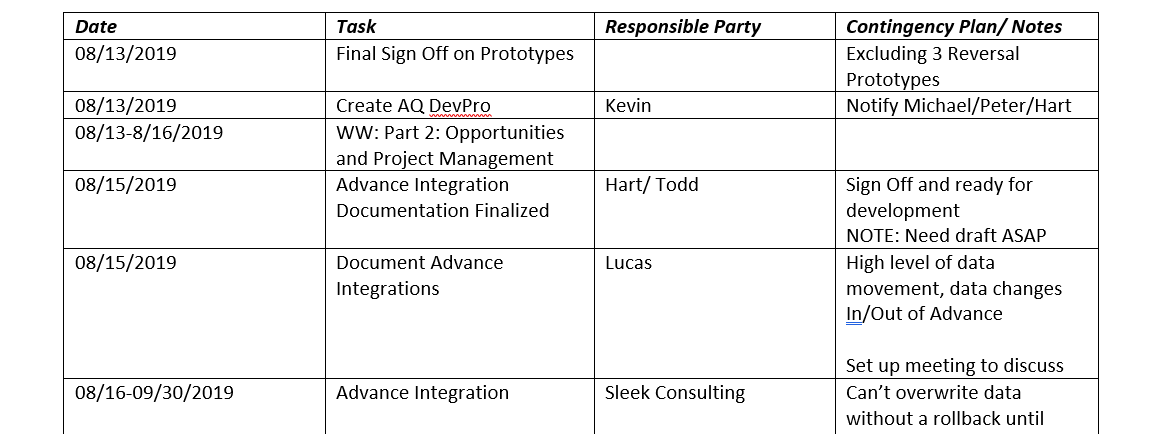
A cut over plan is developed to identify and manage the details and activities of the last 3 months before go live.
Some of these activities are major tasks and others are quick and simple but essential for a smooth move into the new system.
Data Considerations — Parallel and Mock Parallel
While you consider the impact of going live within your organization, it is important to understand if parallel data entry is essential. After go live, parallel begins and means that each day’s data is entered consistently on both systems, and the results are checked qualitatively and quantitively, assuring auditors, boards, and management that the new system will be adequate, the staff is trained, and the appropriate information is available.

This practice is becoming less frequent as many organizations opt for mock parallel instead. Mock parallel is similar to parallel data entry, and it often involves the same qualification measures, but it is done in a staggered approach approximately 60-90 days before going live.
These efforts are typically managed across all of the teams that have data entry and/or reporting needs. Mock parallel efforts involve training on new functionality, utilizing the newly acquired knowledge to add data to your new system, thus testing your understanding and application.
It also involves answering questions to clarify and build on your knowledge base and expertise over 9-12 weeks.
Mock parallel can provide an opportunity to consider any missing needs like reports or day-to-day tools. Adding these new functions, reassessing weekly, and improving on your data entry skills and deliverables are desired outcome of mock parallel, along with auditor and financial reports.
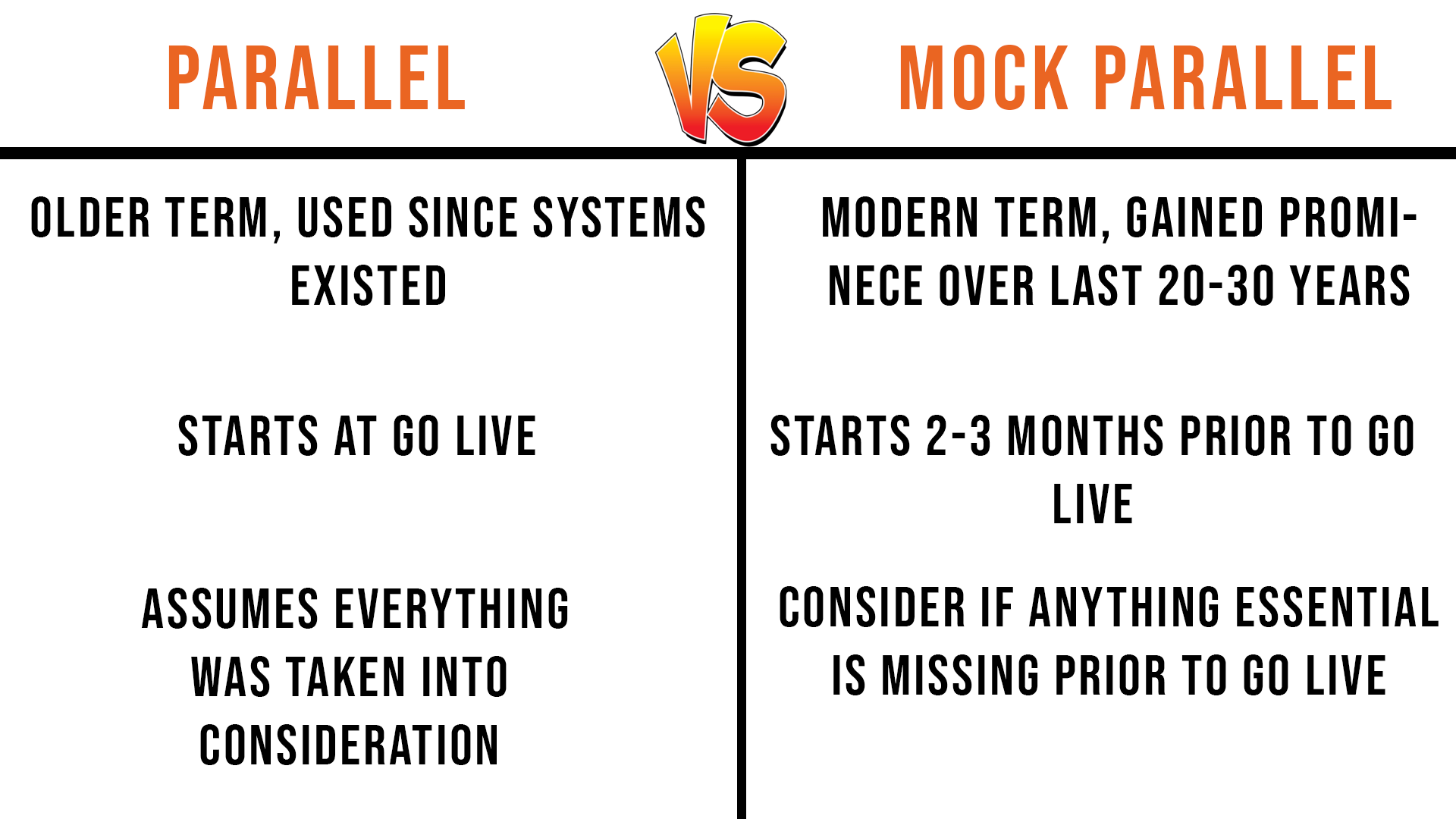
Time to Choose: System Selection
Now that you have your initial timeline and budget, and, a beginning plan for moving forward, the next step is system selection.
System selection is the process of identifying, assessing and selecting a particular system to fulfill a business need.
This includes performing a needs assessment which is a detailed list of all of the business functions that the new system will handle.
Note: If you performed the system assessment earlier, these details can be utilized as an initial list of functional system needs.
After the needs assessment is complete, the current systems on the market that provide these specific business functions must be identified. Your implementation partner should have the list of potential systems to send your RFP (Request for Proposal), or you will need to do some research to create a comprehensive list.
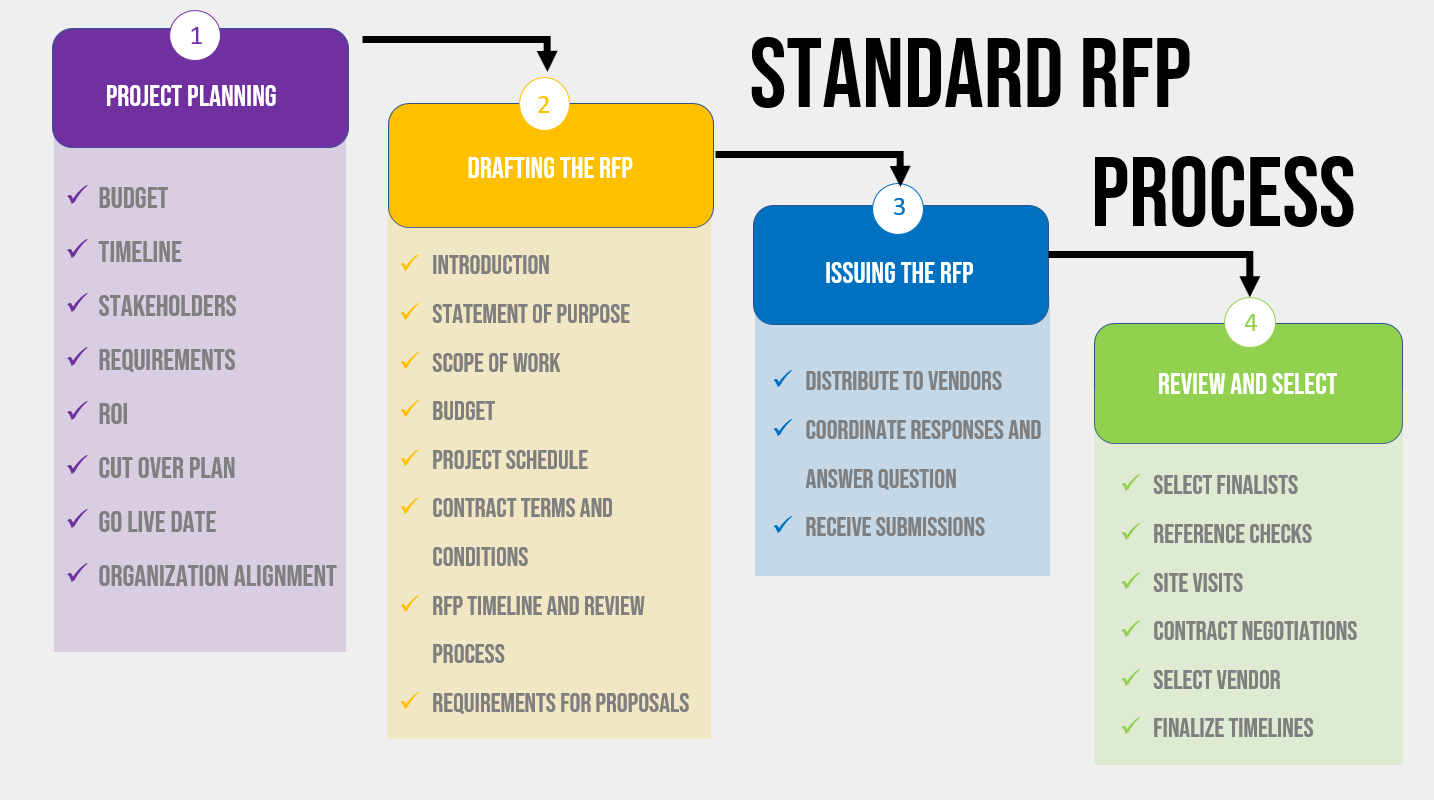
Send your RFP to the potential system vendors including your detail list of business needs. This process will help identify the systems that will fit within your organization’s technical landscape.
After the RFPs are returned and a list of vendors that match your needs has been assembled, defining a demonstration schedule is essential. This schedule should be adhered to by all of the vendors, allowing for comparison between systems.
Setting up and attending demonstrations, assessing the system capabilities and the vendor’s credentials, scheduling and attending existing client site visits, answering specific questions on functionality, selecting a vendor, contract negotiations, and finalizing implementation schedules and timeline all follow this intial process.
Your All Set!
With a good plan in hand, your team is ready for system implementation. The expectations of the staff’s time is clear, your ROI expectations are understood, your timeline is adequate and your budget will cover the details of automation, training and other implementations aspects.
Good luck! This is a special opportunity to be an insider.
Want an expert’s opinion without the pressure of a sales call?
I have made a career of managing implementations. We have managed almost 200 successful Advancement Implementations.
Get in touch with us for a free consultation. You’ll get our honest opinion on your situation and nothing more.

Connect With Us.
©2019 Sleek Consulting LLC. All rights reserved.



